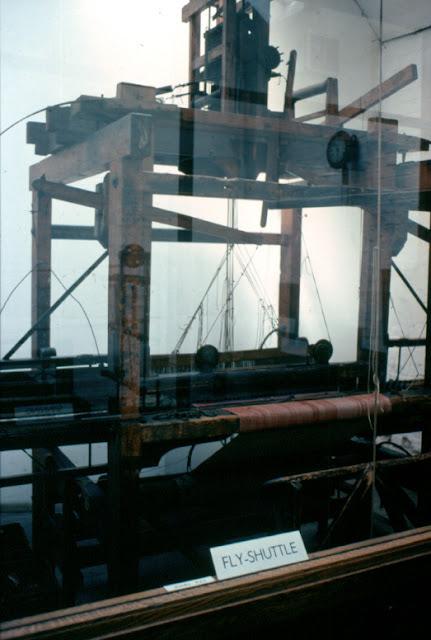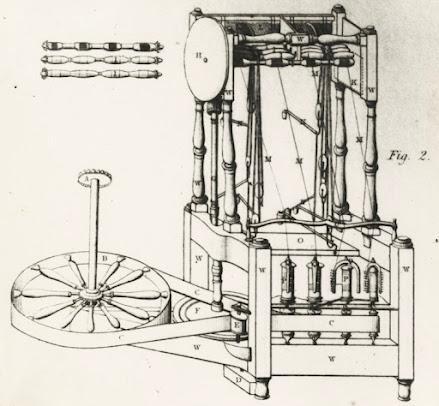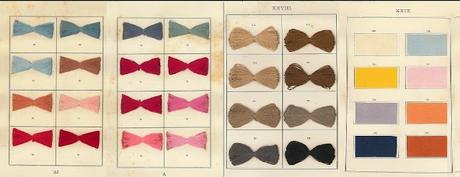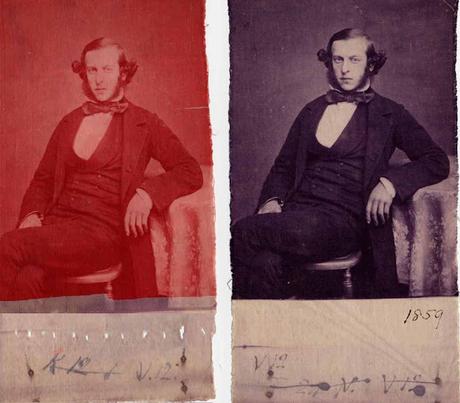The quick development of the textile industry at the beginning of the Industrial Revolution in the 1700s was largely due to some clever Lancashire lads. Three major innovators were John Kay (1704-1779) from Bury, Richard Arkwright (1732-1792) from Preston and John Mercer (1791-1866) from Great Harwood.

John Kay, Richard Arkwright and John Mercer (images: LCC Museum Service/Lancashire Archives)
John Kay invented the flying shuttle machine that allowed a single weaver to weave significantly wider fabric and it could be mechanised. Kay’s invention patented in 1733, sped up the process and also the need for spun yarn.
Flying Shuttle Machine (image: Lancashire Archives)
This is where Arkwright steps in, the man who became known as the ‘father of the modern industrial factory system’. Whilst traveling across Britain collecting hair for his wig business he met John Kay. He was so taken with Kay’s machine that he had one secretly built and then developed his own spinning frame known also as the water frame which expedited production. Arkwright also developed a rotary carding engine that became important in textile manufacturing. Not sure what happened to his wig business.
Richard Arkwright's Water Frame - Drawing 1769 (image: Lancashire Archives)
John Mercer contributed to the development of the textile industry differently. According to Vicci McCann, Archivist – Engagement Lead at Lancashire Archives:Mercer was a self-taught chemist and particularly interested in the dying process, which led him to develop a process still used in the textile industry today called 'mercerisation'. He also practiced withprinting early photographs with a color wash on fabric.

Dye Samples (image: Lancashire Archives)

Samples of John Mercer Printing Photographs on Fabric (image: Lancashire Archives)
I had no idea what mercerisation was so looked it up. According to Oecotextiles it is:a process applied to cellulosic fibres – typically cotton (or cotton-covered thread with a polyester core) but hemp and linen can be mercerised also – to increase luster.At the beginning of the American Civil War (1860-1865) there were 2,650 Lancashire cotton mills in Lancashire. The war had a devastating impact on the textile industry creating a Cotton Famine of the high quality raw cotton (Surat cotton was substituted at that time) causing much hardship.The industry peaked around 1912, producing 8 billion yards of cloth. Production went into overall significant decline during WW I when cotton manufactured products could no longer be exported abroad and for other various reasons continued its downturn.The industry did have a boost during WW II with uniforms and parachutes in high demand. The boost continued into the 1950s when a large number of people came to Britain from the Indian sub-continent and were encouraged to find work in the mills creating opportunities to increase the number of shifts and ultimately increase production.Competition from abroad followed shortly thereafter causing Lancashire mills in the 1960s and 1970s to close at a rate of nearly one a week. By the 1980s the textile industry sadly had all but disappeared leaving empty buildings within communities needing to reinvent themselves.In 2021 there were 158 mills still in existence in Lancashire and 93 textile mills in Pendle alone. Many of these are still vacant since closing or are not being used to their full potential. A current Pendle Council project has plans to create a ‘design code’ with the local community for the remaining Pendle area mill buildings offering hope for preservation and possible new life for many of these formidable structures.To see an historic mill in action you can visit Queen Street Mill Textile Museum in Burnley and Helmshore Mills Textile Museum in Helmshore, both run by Lancashire County Council Museum Service.And now for something completely different…Threads
Make a skirt or shirt or pants
for naked snakes and elephants
and other creatures small or tall
that wear no clothes, no clothes at all
even if they’re covered with hair
essentially their butts are bare
but then who cares, they could care less
whether they wear a fancy dress
or strut about in a fancy suit
they do not care or give a hoot,
but owls hoot and owls fly
covered in feathers in the moonlit sky
as I’m dreaming of fabric, a needle and thread
dressed in pajamas snug in my bed.
Thank you for reading.
Kate
J
Sources
BBC, 2014. Boom to Bust the Decline of the Cotton Industry. https://www.bbc.co.uk/nationonfilm/topics/textiles/background_decline.shtml#:~:text=During%20the%201960s%20and%2070s,West%20had%20all%20but%20vanished Accessed 2 September 2024.
Britain Express, 2024. Richard Arkwright. https://www.britainexpress.com/History/bio/arkwright.htm Accessed 2 September.
Eugene Textile Centre, 2024. John Mercer. https://www.eugenetextilecenter.com/john-mercer Accessed 28 August.
Lancashire County Council, 2024. John Kay and the flying shuttle. https://lancashiremuseumsstories.wordpress.com/2020/05/22/john-kay-and-the-flying-shuttle/ Accessed 2 September.
Macdonald, R., 2024. What next for borough’s 93 ‘at risk’ mills?. https://www.bbc.co.uk/news/articles/cy6898jv26wo Accessed 2 September.
Make It British, 2024. The Decline of the Lancashire Cotton Mills. https://makeitbritish.co.uk/blog/lancashire-cotton-mills/#:~:text=By%201860%20there%20were%202650,exported%20all%20over%20the%20world Accessed 28 August.
McCann, V. 2024. Email to Kate Eggleston-Wirtz, 18 June.
Oecotextiles, 2024. What Does “Mercerized” Cotton Mean?. https://oecotextiles.blog/2012/12/05/what-does-mercerized-cotton-mean/ Accessed 6 September.. Email ThisBlogThis!Share to TwitterShare to Facebook
